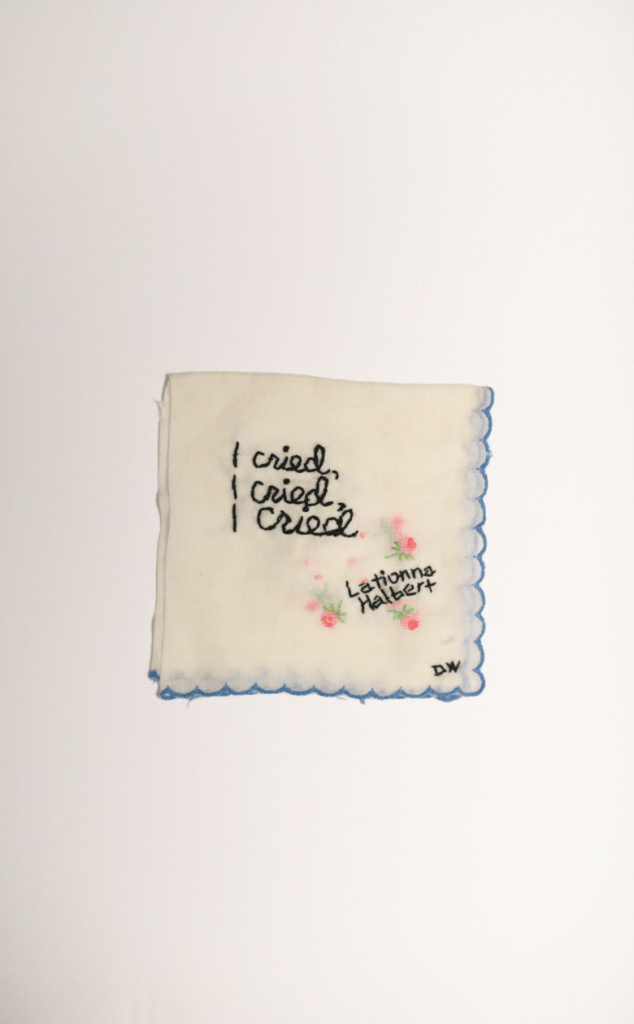
“Concerns About Being Unprepared for Parenthood”
# The Intersection of Art, Reproductive Justice, and Activism: Diana Weymar’s Abortion Embroideries
Art has long been a platform for both personal expression and political activism, serving as a vehicle for challenging societal norms, exposing injustices, and advocating for underrepresented voices. Diana Weymar, an artist known for her subversive stitching works, exemplifies the potential of art to engage with pressing social issues. In her poignant, embroidered pieces centered on reproductive justice, Weymar deftly merges the traditionally ‘feminine’ medium of embroidery with the powerful, deeply personal narratives surrounding abortion—a topic often shrouded in silence and stigma.
### The Power of Embroidery: Transforming a Feminine Craft into Political Expression
Embroidery, with its associations of domesticity and femininity, has often been seen as a quaint, decorative art form. However, throughout history, it has also been a tool for rebellion. In Weymar’s work, this domestic craft is transformed into a radical medium for feminist commentary on reproductive rights.
Weymar’s embroidered pieces, rendered on delicate handkerchiefs and vintage textiles, subvert societal expectations about women and femininity. These materials, typically used for personal hygiene and decorative purposes, are recontextualized to convey forceful messages about women’s struggles for autonomy over their bodies. Quotes like “Pro-life is pro-death” and “Abortion is about a patient’s hopes and dreams and how they want to be in the world” are stitched into dainty floral fabrics—juxtaposing the softness of the medium with the hard, often unspeakable truths of the subject.
By using embroidery as her chosen form of protest, Weymar quietly, yet unmistakably, dismantles the boundaries between the public and private realms. Traditionally, women’s bodily experiences—including menstruation, childbirth, and abortion—have been shrouded in secrecy, rendered invisible by societal expectations of femininity. In Weymar’s work, the needle becomes a weapon against this erasure, bringing these private matters into shared, visible spaces.
### Personal Storytelling Meets Collective Action
One of the striking contrasts in Diana Weymar’s abortion embroideries is the way they merge personal experiences with collective activism. Inlaid with quotes pulled from articles and interviews, Weymar’s work highlights the lived experiences of women grappling with abortion in a sociopolitical landscape that increasingly seeks to limit their reproductive freedom.
The quotes featured in her embroideries are pulled from journalism centered around reproductive justice, created by the **Economic Hardship Reporting Project (EHRP)** and co-published by outlets like *The Guardian*, *Literary Hub*, *Teen Vogue*, and *In These Times*. These quotes present a range of perspectives and stories, many of which underscore the nuances of each woman’s abortion experience, from emotional struggles to triumphs in asserting agency over her own body.
Take her piece that reads, *“I cried.”* It’s a simple, yet evocative phrase—one that reveals the complicated emotional dimensions of abortion for many women. These brief, powerful testimonies reflect a broader truth: abortion is not a monolithic experience but deeply personal, tied to a patient’s unique circumstances, dreams, and desires for her own life. Weymar’s work does what journalism alone sometimes cannot: it translates these individual recollections into objects of contemplation and activism.
### The Unspoken Stories: Embroidering a Legacy of Courage
Weymar’s work also touches on the notion of silence and the **untold stories** surrounding reproductive rights. Women’s abortion stories, so often kept in the shadows due to fear of judgment or political reprisal, are now stitched into fabrics that might have once been quietly tucked away in drawers. Just as handkerchiefs are made practical—to absorb the messiness of life so the “exterior” remains composed—these fabrics have been used to wipe away tears, to contain private grief.
These stories of untold resilience and courage are now transformed into public declarations of strength through Weymar’s art. The juxtaposition of delicate embroidery with blunt, unflinching phrases mirrors the duality many women live with—straddling the roles of demure, stereotypically ‘obedient’ figures and holders of deep, often painful truths. By immortalizing these personal stories in hand-stitched form, Weymar invites viewers to ponder just how many untold truths exist beneath the surface of traditional femininity.
A particular piece asserts, *“In places like Texas”*—a reference to both the geographical and psychological landscapes where women’s reproductive choices are restricted. Above all, Weymar’s work challenges viewers to recognize the courage needed to speak out in places, and moments, where self-expression carries emotional or political risks.
### A Call to Action: Art Amid Political Crises
Diana Weymar’s embroideries are not merely artistic statements—they are also calls to action, urging a reckoning with the ways